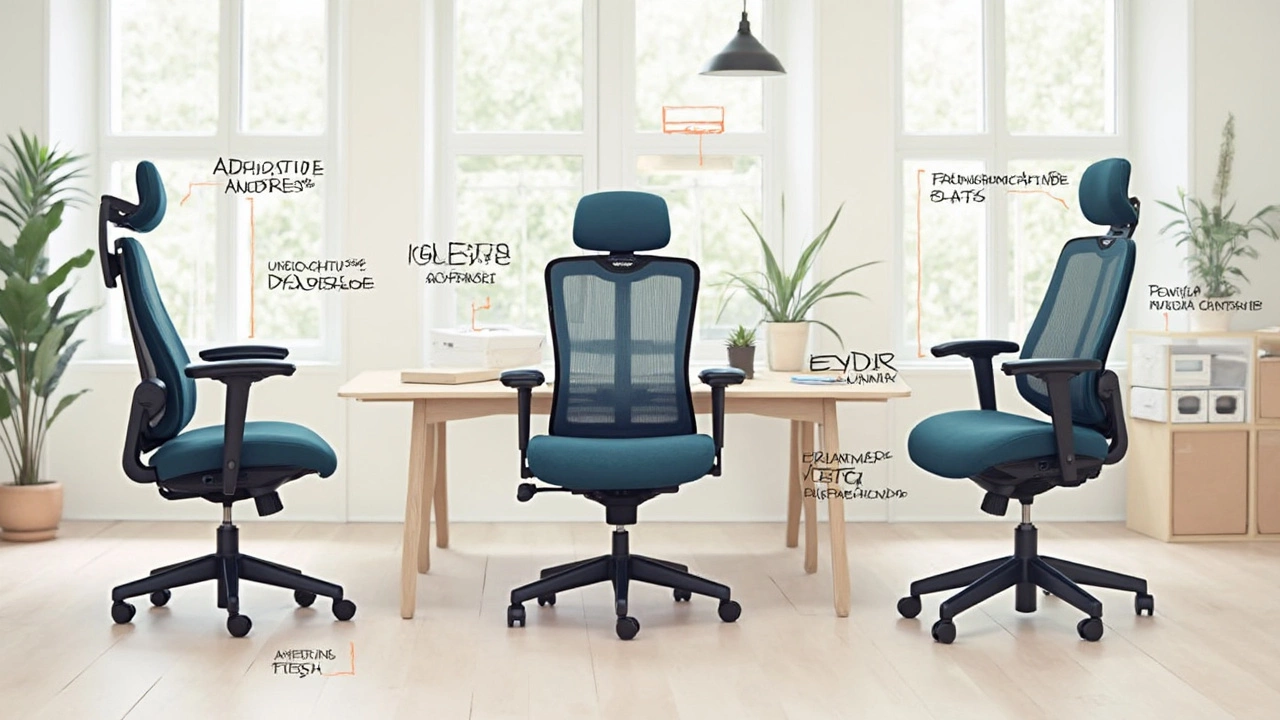Sore neck, stiff back, and tingling legs aren’t just part of the office grind—they’re warning signs that your chair isn't doing its job. If you spend most of the day parked at your desk, picking the right chair isn’t just a nice-to-have. It's a game changer for your focus, productivity, and how your body feels when you finally clock out.
Most people think all office chairs are basically the same, but the differences actually matter a ton when it comes to hours at a time. Look at it this way: sitting is the new smoking, and the wrong chair only makes it worse. Poor support, junky padding, or flimsy armrests can add up to long-term aches you just can’t stretch away. Companies love tossing around words like 'ergonomic' and 'supportive,' but there’s real science—and real everyday experience—behind what actually keeps your back, neck, and arms happy through a long workday.
Ready to ditch the pain and finally get comfortable? Here’s what really matters when you’re about to put in a full day’s sit, plus some overlooked facts you'll wish you knew sooner.
- What Makes a Chair Good for Long Sitting?
- Key Features to Watch For
- Real-World Testing and User Experiences
- Top Picks Worth Your Money
What Makes a Chair Good for Long Sitting?
If you’re spending eight, ten, or even more hours at your desk, grabbing just any office chair isn’t going to cut it. The best office chair for long hours sitting isn’t about looks or trendy mesh. It comes down to how it supports your body, keeps you moving, and stops those nagging aches from creeping in as the day drags on.
Let’s get into what really matters. First, proper lumbar support is a must. Your lower back needs a chair that matches its natural curve, not a flat board or a squishy cushion that disappears by noon. Studies actually show that solid lumbar support can cut down on back pain and help posture, especially for folks sitting over 6 hours a day. No more slouchy turtle pose needed.
Another big thing: adjustability. Height, armrests, lumbar, and even seat pan—all these should move to fit your body, not the other way around. One-size-fits-all is a lie in office chairs. Good adjustability means you can dial in comfort whether you’re short, tall, or somewhere in between. Look out for chairs with lots of movable parts—it honestly makes more difference than the material or brand.
Some people think padding is the whole game, but there’s a sweet spot. Too firm and your butt goes numb. Too soft and you sink in, losing that support. High quality foam or mesh that’s breathable and holds shape all day is what you want.
If you like proof, check out this quick summary of why key features matter for health and comfort:
| Chair Feature | Benefit for Long Sitting |
|---|---|
| Lumbar Support | Reduces pressure on lower back, keeps spine healthy |
| Adjustable Seat Height | Keeps feet flat, improves circulation |
| Adjustable Armrests | Prevents shoulder and neck strain |
| Breathable Material | Less sweat, more comfort over time |
Last thing—movement matters. Chairs with a tilt or recline feature can help, since staying stuck in the exact same spot is a recipe for tight muscles and afternoon stiffness. Shifting around is what your body wants, even if it’s just a little.
All these factors together are what separate a true ergonomic chair designed for long sessions from a just-okay seat. Don’t fall for the cheapest option or cool looks—your body will thank you later.
Key Features to Watch For
If you’re hunting for the best office chair for long hours sitting, don’t just look for a fancy brand or a high price tag. Focus on features that actually make a difference in comfort and body support.
- Adjustable Lumbar Support: Your back needs more than a basic curve in the chair. A good chair lets you move the lumbar pad up and down, and sometimes even in and out, so your lower spine actually feels supported. Skipping this leads to slouching and ache city by lunchtime.
- Seat Depth and Width: If the seat’s too deep, your knees lose support. Too shallow, and you feel off-balance. You want roughly two to four fingers’ space between the edge of the seat and the back of your knees. Adjustable seat pans are a huge win if you’re taller or shorter than average.
- Backrest Recline and Tilt: Staying locked upright all day is rough on the spine. The best chairs let you recline a bit, with tension controls, and hold that position. Even a slight angle takes a load off your discs. Bonus if you can lock the tilt in at different angles.
- Armrest Adjustability: Fixed armrests = shoulder problems. Look for 3D or 4D armrests (they move up/down, in/out, front/back, and sometimes even rotate). This keeps your arms relaxed whether you’re typing or taking a call.
- Breathable Material: Mesh keeps you cooler, while thick foam can get sweaty after a couple hours. There’s no universal winner here, but avoid cheap plastic-y fabrics that crack or stick to your skin.
- Sturdy Build and Casters: Don’t ignore the base and wheels. A five-point base adds stability, and quality casters roll smoothly on carpet or hardwood. Wobbly bases are a nightmare if you move around a lot.
Here's an easy comparison of what to look for when judging an office chair for long daily use:
| Feature | Why It Matters | Tip |
|---|---|---|
| Lumbar Support | Supports natural back curve | Try it before buying, if possible |
| Armrest Adjustability | Reduces wrist and shoulder strain | Elbows should bend at 90 degrees |
| Seat Depth | Prevents knee and leg pain | Leave space behind knees |
| Recline & Tilt | Lets muscles relax, prevents fatigue | Change angles often |
| Material | Keeps you cool and comfortable | Choose breathable mesh for all-day use |
One more thing: try out the chair settings when you get it home or to your office. Lots of folks buy a feature-packed chair and never adjust it to fit their body, missing out on half the benefits. Make sure the chair fits you, not the other way around.

Real-World Testing and User Experiences
Fancy marketing means nothing if a best office chair falls flat after a week of real use. So how do these chairs actually hold up when people spend hours in them, day after day? Turns out, user reviews, long-term tests, and company return rates can tell you more than official product descriptions ever could.
Let’s get straight to the pain points most folks report. Cheap foam in seat cushions? It compresses after a month or two. That super-soft padding you love at first turns pancake-flat by the end of a long project. Mesh backs get rave reviews for breathability, but the lower-cost ones start sagging fast, which leaves your spine with zero support. Adjustable armrests are gold—unless they’re wobbly or only move up and down with no side-to-side motion (which a ton of budget models are guilty of).
Honestly, people who sit 8 or more hours a day say the difference between a $100 chair and a $400+ model is night and day. Higher price doesn’t guarantee quality, but cheaping out is almost always a regret. Office workers and home gamers who post full breakdowns online often mention the same winners: the Steelcase Leap, Herman Miller Aeron, and Secretlab Titan. Those chairs see thousands of hours of real-world use without the usual creaks, aches, or slumping support.
Here’s what hundreds of users flag as the non-negotiable winners after months of sitting:
- Seat comfort that lasts (memory foam or thick, dense padding stays comfy for years, not weeks)
- Back support that actually follows your spine—adjustable lumbar works best for most people
- Armrests that move in at least three directions (height, width, pivot) so wrists get a break
- Stable recline and tilt lock that lets you actually lean back without feeling like you’ll flip over
Check this quick table showing what users said about popular office comfort brands after 12 months:
| Brand | User Comfort After 1 Year | Common Issues |
|---|---|---|
| Steelcase Leap | Excellent | Minor scuffing, price |
| Herman Miller Aeron | Excellent | Mesh can be chilly |
| Secretlab Titan | Very Good | Heavier chair, firm seat |
| Generic Budget Chair | Poor | Flattened seat, creaky frame |
Here's one more thing most buyers miss: warranty and customer support. The best brands back up their claims; if your lumbar breaks at month 13, good companies send a replacement free. Cheaper chairs? Good luck—most people end up tossing them. So when you’re picking the best chair for sitting long hours, don’t just go by looks or trending YouTube videos. Actual user stories and long-term numbers tell you what will still feel good next year, not just next week.
Top Picks Worth Your Money
Let’s get straight to what you really want: the best office chairs for sitting long hours. With so many models promising the world, it's easy to get lost in marketing buzzwords. But here are real-world favorites that have stood up to long-haul use, based on user reviews, expert opinions, and what actually matters for comfort and health.
- Herman Miller Aeron – This chair is basically the OG of ergonomic chairs. The mesh back keeps you cool, it adjusts just about everywhere, and it’s built like a tank. Sure, it’s pricey (around $1,200), but you’ll see these in startups and Fortune 500s for a reason. The adjustable lumbar support is a lifesaver if you get lower back pain easily.
- Steelcase Leap – Another high-end pick, the Leap stands out for its live-back tech, which actually shifts with your spine as you move. The seat depth and armrest range work for all sorts of body types. Out of 700,000 chairs used in a five-year survey, Steelcase Leap was one of the only models where people reported less lower back pain after six months.
- Autonomous ErgoChair Pro – If you want solid support under $500, this one's reliable. It’s fully adjustable and has a flexible back. You get a headrest and breathable materials too. It’s not luxury, but it massively outperforms generic office chairs in comfort tests.
- HON Ignition 2.0 – On a tighter budget? This chair doesn’t look flashy, but it nails the basics: lumbar support, adjustability, and a sturdy frame for around $350. Thousands of office workers stick with HON because it combines workplace-durability with enough comfort for marathon sitting sessions.
Here's a quick look at how these best office chairs stack up on important features:
| Model | Price Range | Main Material | Weight limit | Warranty |
|---|---|---|---|---|
| Herman Miller Aeron | $1200-1500 | Mesh | 350 lbs | 12 Years |
| Steelcase Leap | $900-1200 | Fabric/Leather Options | 400 lbs | 12 Years |
| Autonomous ErgoChair Pro | $400-500 | Mesh | 300 lbs | 2 Years |
| HON Ignition 2.0 | $300-400 | Mesh/Fabric | 300 lbs | 5 Years |
If you’re in the chair for more than six hours a day, don’t cheap out. A good chair is way cheaper than endless trips to the chiropractor. Look for strong warranties and generous return policies, because what feels great for one person might annoy you after a week. And if you’re still tempted by those $99 options online, just remember: you’re going to be using this thing more than your mattress, so it’s worth investing in real office comfort.


Write a comment